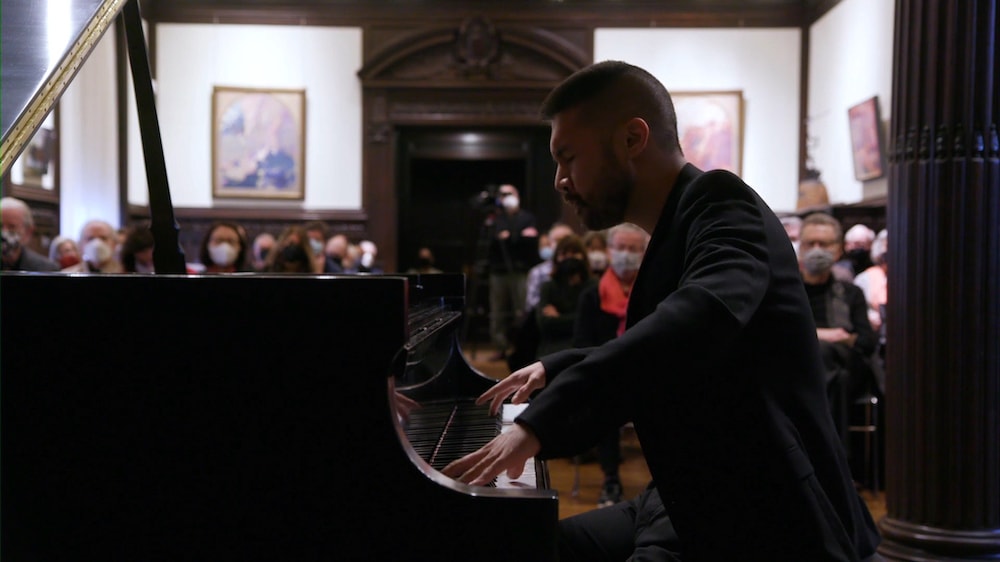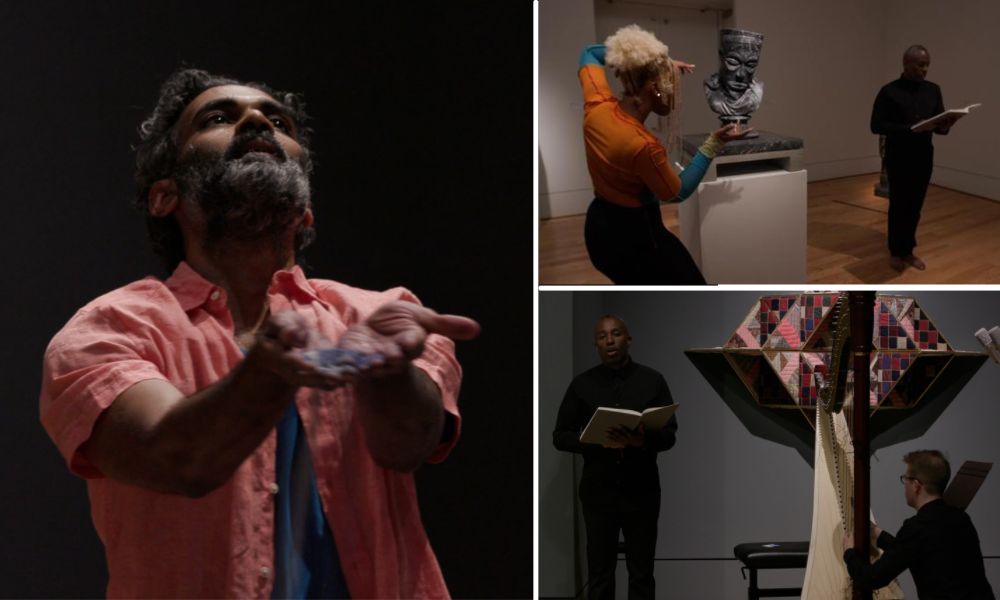It’s one of the longest-running music series in Washington, but the Phillips Collection’s program is not content with resting on its laurels. As part of centennial celebrations that began last year, America’s first museum of modern art has commissioned ten new compositions, most touching upon a specific artist or artwork contained in the institution’s collection. The effort is part of a legacy of presenting innovative musical voices.
Now in its 81st year, the program has a long tradition of hosting music old and new from September to May in its oak-paneled Music Room, filled with curated artwork and a painstakingly rebuilt Steinway piano. The collection’s crown jewel, Pierre-Auguste Renoir’s Luncheon of the Boating Party (1880–1881) sometimes makes an appearance in a room whose keynote performances include pianist Glenn Gould’s 1955 U.S. debut. The intimate space is part of the 1897 three-story Georgian Revival building of red brick and sandstone that was the childhood home of visionary art collector Duncan Phillips.

“It’s a unique place to work and a great place to present a show or imagine a show, because there’s a wide range of possibility,” said Conrad Tao. The 27-year-old pianist-composer powerhouse opened last season — with violinist Stefan Jackiw, sounding the first notes in the Music Room in 10 months for a live-streamed, online-only concert. On January 30, he presented the museum’s first music program before a live, ticketed audience in nearly two years.
This year’s event was originally intended to showcase Catherine Lamb’s new composition inspired by concepts in Paul Klee’s pedagogical sketchbook. Written for synthesizer, MIDI keyboard, and cello, the piece was co-commissioned by the Phillips and Little Island. Winter storms kept cellist Jay Campbell away, so Tao gave a solo recital instead. The Lamb piece will now receive its Phillips premiere later this year or next year. “It’s really great that we’ll be able to present this with all that information and all of that inspiration, all the atmosphere of Klee’s work contextualized,” Tao said.
That context is the beating heart of the music program at the Phillips and its innovative commissions, which provide an unusual degree of free rein to composers and performers. “Artists will reflect the world back. You don’t have to do that work for them. You gift them the resources and the platform to do the work that they do,” said director of music Jeremy Ney. That approach has a long history at the museum, whose eponymous founder would support artists by paying their rent or giving them a stipend so that they could create unencumbered and without limitations.
The ephemeral nature of musical performance tugs and pulls at the tangible visual art. The tension between the two art forms is ripe for creative output. “If you are in a position of programming in an art museum, you can’t ignore the art on the walls,” Ney explained. “You can demonstrate that music is a vital, living, breathing art form. It’s also a critical tool to think with or think about in relation to the visual arts. It’s not just performance.”

So when the Phillips taps artists to create new pieces, they are most often in dialogue with the collection’s visual art. An October 10 performance by the all-female Aizuri Quartet featured Lembit Beecher’s These Are Not Estonian Flowers, inspired by Alma Thomas’s painting Breeze Rustling Through Fall Flowers (1968), and Paul Wiancko’s Purple Antelope Sound Squeeze, a riff on Sam Gilliam’s mixed media Purple Antelope Space Squeeze (1987).
“I tried to construct the piece as Gilliam might have constructed his work,” Wiancko said in introducing his composition, made up of 12 miniatures “fighting for your attention” and patched together with additional melodic material. Speaking to a private audience at a time when the Phillips had yet to resume public performances due to the pandemic, Beecher explained how he kept hearing a different tune every time he looked at Thomas’s painting, which hovers between abstraction and representation. So he too wrote different fragments, here based on different aspects of Thomas’s life and work, then stitched them together. “As I reached the end of the piece, the music ends up in a place that’s very personal, but also a place I would not have ended up with, certainly not in the way that I did, without the conversation with Alma Thomas’s painting,” he explained.
Between last season and the current season, commissions and co-commissions have included works by Benjamin Attahir, Nathalie Joachim, Gabriel Kahane, Outi Tarkiainen, and inti-figgis vizueta. An endowment makes possible this ambitious programming, which accounts for only about 4.5 percent of the total institutional operational budget. Two of the planned premieres had to be rescheduled for a later date — Lamb’s piece and Marcos Balter’s Therapy for countertenor and string quartet.
And yet there are just 150 seats in the Music Room — and only half that number when the public first returned in January — so how can the wider public access these programs? Ultimately, the health crisis has pushed and allowed the Phillips — along with countless performing arts presenters, orchestras, and ensembles — to make overdue changes to improve accessibility, community connection, and, ultimately, relevance. At the Phillips, the answer came in the form of recording and live streaming performances. There are now virtual tickets in addition to in-person seating for every show.
“I didn’t just want to be an ostrich,” said Ney, reflecting on the dog days of summer 2020. The museum’s 80th music season was coming up, one that overlapped with its centennial. He and his team quickly pivoted to live streaming performances and recorded digital concerts, something the Phillips had never done before. The response was swift and overwhelming.
In January and February 2021 alone, the program saw a 300% increase in concert attendance, compared with pre-pandemic, in-person performances. Thousands of people signed up, many from abroad, and the museum’s social media footprint grew exponentially. But since charging for its live streams this season ($15, with a reduced rate of $10 for members), fewer people have tuned in to watch the content. “There’s still some learning to do about whether a paid model works or whether a free model is better, but you don’t know until you try. It’s all an experiment,” Ney explained. Rather than attempt to replicate the concert experience online, Ney focused on how the Phillips could “bring in the visual arts in a way that we might not be able to in the transitory moment of a live performance.”
For all the allure of digital programming, none of it makes up for the experience and energy of live performance, the kind in which Tao reveled in January. He thrives on breaking expectations, blending genres, and creating ad hoc. “When it’s just outside my ability to define it and I also feel that attraction, for me that’s the beautiful thing about music-making and maybe art writ large — that sort of capacity to recognize other people through this very precise mode, whatever that ends up being for someone,” Tao explained.
The former child prodigy espouses a centuries-old tradition of expanding the physical limitations of the piano. Lately, he’s focused his attention on getting the piano to sing beyond the keys as a means to “activate listening,” but while using only the keys — no magnets or other objects dropped in the piano this time. “I was trying to explore if it was possible to write music based on a melody that’s at the edge of what you’re hearing and what you’re imagining,” he said in describing his 2021 piece “Keyed In” among those he performed at the Phillips. The guiding melody here lies in the resonances of the sound, phantom notes created after spinning out his fingers across the keyboard. In that sense, it would have been an excellent companion for Lamb’s The Additive Arrow, which takes as its entire tonal palette pitches from the overtone series of 10Hz.

Another experimental effort, though reserved for online audiences, came in a commission involving music and dance linked to an exhibition of new works by interdisciplinary artist Sanford Biggers. The digital format allows viewers to catch glimpses of an earlier iteration of Biggers’s sand-floor installation (Creation/Dissipation, in Budapest in 2002), but also to see and hear in ways that would not be possible from a fixed, seated position. Thus, we follow dancer Nicoletta de la Brown as she lures us into a room containing Biggers’s Fool’s Folly against the backdrop of text on pandemic losses read by Sheldon Scott and Omolu, a piece written for solo harp (Parker Ramsay) by Brazilian-American composer Balter that references the Yoruban spirit of healing. Brown and Daniel Phoenix Singh ultimately carry and spread the colored sands, rendering unrecognizable the temporary motif inspired both by Tibetan mandalas and quilts created by women from the isolated African American community of Gee’s Bend, Alabama.
Providing composers and performers such freedom in commissions, where other institutions might try to have a much heavier hand, is liberating. The artists can push further the realm of the possible. In Tao’s case, that means extending a listener’s experience beyond the subliminal reaches of the mind. “There is an interest in destabilizing audiences a little bit so they can realize that there are other ways of hearing, or realize things about their hearing and their perspective,” he said. “That’s the hope, because then to me it means that this is not just a style that you buy off the iTunes store, that music is not just a genre.”
To learn more about The Phillips Collection’s music program visit phillipscollection.org/music.
The next Phillips music program will feature the DC debut of British pianist Mishka Rushdie Momen on March 13, 2022, from 4:00 to 5:30 pm at The Phillips Collection, 600 21st Street NW, Washington, DC. In-person tickets are $45 general, $25 members; virtual tickets are $15 general, $10 members. For more information and tickets, go online.
The following week, countertenor Anthony Roth Costanzo performs in a duo recital with Bryan Wagorn at the piano — after pandemic restrictions prevented the Shanghai Quartet from traveling for the premiere of a commission by Marcos Balter — on March 20, 2022, from 4:00 to 5:30 pm at The Phillips Collection, 600 21st Street NW, Washington, DC. In-person tickets are $45 general, $25 members; virtual tickets are $15 general, $10 members. For more information and tickets, go online.”
COVID Safety: The Phillips Collection requires that visitors 5 years of age and over show proof of vaccination or a same-day negative COVID-19 test upon entry, along with a government-issued photo ID for visitors 16 and over. Proof of a negative same-day COVID-19 test must come from a health care provider. Results from a self-administered COVID-19 test will not be accepted. All safety COVID-19 protocols including mask-wearing and physical distancing will be followed. For more information on proof of vaccination, consult the museum’s safety guidelines.




